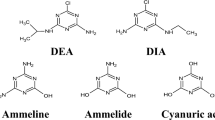Abstract
UV photolysis and UV based advanced oxidation processes (AOPs) are gaining more and more attention for drinking water treatment. Quantum yield (ø) and molar absorption coefficient (ε) are the two critical parameters measuring the effectiveness of photolysis of a compound. The product of the two was proposed as a fundamental measure of a constituent’s amenability to transformation by photolysis. It was shown that this product, named the photolysis coefficient, k p , can be determined using standard bench tests and captures the properties that govern a constituent’s transformation when exposed to light. The development showed the photolysis coefficient to be equally useful for microbiological, inorganic and organic constituents. Values of k p calculated by the authors based on quantum yield and molar absorption coefficient data from the literature were summarized. Photolysis coefficients among microorganisms ranged from 8500 to more than 600000 and are far higher than for inorganic and organic compounds, which varied over a range of approximately 10 to 1000 and are much less sensitive to UV photolysis than the microorganisms.
Similar content being viewed by others
References
Glaze W H, Kang J W, Chapin D H. Chemistry of water treatment processes involving ozone, hydrogen peroxide and ultraviolet radiation. Ozone Science and Engineering, 1987, 9(4): 335–352
Bolton J R. Ultraviolet Applications Handbook, 3rd ed. Edmonton, Canada: Bolton Photosciences, Inc., 2010
Li K, Hokanson D R, Crittenden J C, Trussell R R, Minakata D. Evaluating UV/H2O2 processes for methyl tert-butyl ether and tertiary butyl alcohol removal: effect of pretreatment options and light sources. Water Research, 2008, 42(20): 5045–5053
Li K, Stefan M I, Crittenden J C. UV photolysis of trichloroethylene (TCE): product study and kinetic modeling. Environmental Science & Technology, 2004, 38(24): 6685–6693
Setlow R B. Cyclobutane-type pyrimidine dimers in polynucleotides. Science, 1966, 153(3734): 379–386
Oguma K, Katayama H, Mitani H, Morita S, Hirata T, Ohgaki S. Determination of pyrimidine dimers in escherichia coli and cryptosporidium parvum during UV light inactivation, photoreactivation, and dark repair. Applied and Environmental Microbiology, 2001, 67(10): 4630–4637
Radany E H, Love J D, Friedberg E C. The use of direct photoreversal of UV-irradiated DNA for the demonstration of pyrimidine dimer-DNA glycosylase activity. In: Seeberg E, Kleppe K, eds. Chromosome Damage and Repair. New York, N.Y.: Plenum Publishing Corp., 1981, 91–95
Einstein A. Über einen die erzeugung und verwandlung des lichtes betreffenden heuristischen gesichtspunkt. Annalen der Physik, 1905, 17(6): 132–148
Rubin M B, Braslavsky S E. Quantum yield: the term and the symbol. A historical search. Photochemical & Photobiological Sciences, 2010, 9(5): 670–674
Bolton J R, Stefan M I. Fundamental photochemical approach to the concepts of fluence (UV dose) and electrical energy efficiency in photochemical degradation reactions. Research on Chemical Intermediates, 2002, 28(7–9): 857–870
Bolton J R, Linden K G. Standardization of methods for fluence (UV Dose) determination in bench-scale UV experiments. Journal of Environmental Engineering, 2003, 129(3): 209–215
Schwarzenbach R P, Gschwend P M, Imboden D M. Environmental Organic Chemistry, 2nd ed. Hoboken, NJ.: Wiley, 2003
HijnenWA M, Beerendonk E F, Medema G J. Inactivation credit of UV radiation for viruses, bacteria and protozoan (oo)cysts in water: a review. Water Research, 2006, 40(1): 3–22
Havelaar A H, Meulemans C C E, Pot-Hodgeboom W M, Koster J. Inactivation of bacteriophage MS2 in wastewater effluent with monochromatic and polychromatic ultraviolet light. Water Research, 1990, 24(11): 1387–1393
Sharpless C M, Seibold D A, Linden K G. Nitrate photosensitized degradation of atrazine during UV water treatment. Aquatic Sciences, 2003, 65(4): 359–366
Watts M J, Linden K G. Chlorine photolysis and subsequent OH radical production during UV treatment of chlorinated water. Water Research, 2007, 41(13): 2871–2878
Li J, Blatchley E R III. UV photodegradation of inorganic chloramines. Environmental Science & Technology, 2009, 43(1): 60–65
De Laat J, Berne F. La déchloramination des eaux de piscines par irradiation UV. European Journal of Water Quality, 2009, 40(2): 129–149
De Laat J, Boudiaf N, Dossier-Berne F. Effect of dissolved oxygen on the photodecomposition of monochloramine and dichloramine in aqueous solution by UV irradiation at 253.7 nm. Water Research, 2010, 44(10): 3261–3269
Lukes P, Clupek M, Babicky V, Sunka P. Ultraviolet radiation from the pulsed corona discharge in water. Plasma Sources Science and Technology, 2008, 17(2): 1–11, article no. 024012
Sanches S, Barreto Crespo M T, Pereira V J. Drinking water treatment of priority pesticides using low pressure UV photolysis and advanced oxidation processes. Water Research, 2010, 44(6): 1809–1818
Baeza C, Knappe D R U. Transformation kinetics of biochemically active compounds in low-pressure UV photolysis and UV/H2O2 advanced oxidation processes. Water Research, 2011, 45(15): 4531–4543
Pereira V J,Weinberg H S, Linden K G, Singer P C. UV degradation kinetics and modeling of pharmaceutical compounds in laboratory grade and surface water via direct and indirect photolysis at 254 nm. Environmental Science & Technology, 2007, 41(5): 1682–1688
Yuan F, Hu C, Hu X, Qu J, Yang M. Degradation of selected pharmaceuticals in aqueous solution with UV and UV H2O2. Water Research, 2009, 43(6): 1766–1774
Rauth A M. The physical state of viral nucleic acid and the sensitivity of viruses to ultraviolet light. Biophysical Journal, 1965, 5(3): 257–273
Stefan M I, Bolton J R. UV direct photolysis of N-nitrosodimethylamine (NDMA): kinetic and product study. Helvetica Chimica Acta, 2002, 85(5): 1416–1426
Sharpless C M, Linden K G. Experimental and model comparisons of low- and medium-pressure Hg lamps for the direct and H2O2 assisted UV photodegradation of N-nitrosodimethylamine in simulated drinking water. Environmental Science & Technology, 2003, 37(9): 1933–1940
Author information
Authors and Affiliations
Corresponding author
Rights and permissions
About this article
Cite this article
Hokanson, D.R., Li, K. & Trussell, R.R. A photolysis coefficient for characterizing the response of aqueous constituents to photolysis. Front. Environ. Sci. Eng. 10, 428–437 (2016). https://doi.org/10.1007/s11783-015-0780-3
Received:
Accepted:
Published:
Issue Date:
DOI: https://doi.org/10.1007/s11783-015-0780-3




